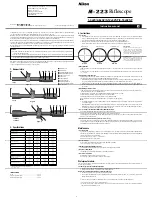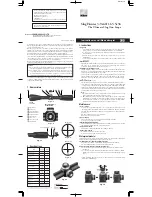
13
To start, turn the smaller thumbscrews that lock the primary
mirror in place a few turns each (Figure 13). Use a screw-
driver in the slots, if necessary.
Now, try tightening or loosening one of the larger collimation
thumbscrews with your fingers (Figure 14). Look into the fo-
cuser and see if the secondary mirror reflection has moved
closer to the center of the primary. You can tell this easily with
the collimation cap and mirror center mark by simply watching
to see if the “dot” of the collimation cap is moving closer or
further away from the “ring” on the center of the primary mirror
mark. When you have the dot centered as much as is possible
in the ring, your primary mirror is collimated. The view through
the collimation cap should resemble Figure 10e. Re-tighten
the locking thumbscrews.
A simple star test will tell you whether the optics are accu-
rately collimated.
star‑testing the telescope
When it is dark, point the telescope at a bright star and accu-
rately center it in the eyepiece’s field of view. Slowly de-focus
the image with the focusing knob. If the telescope is correct-
ly collimated, the expanding disk should be a perfect circle
(Figure 15). If the image is unsymmetrical, the scope is out
of collimation. The dark shadow cast by the secondary mirror
should appear in the very center of the out-of-focus circle, like
the hole in a donut. If the “hole” appears off-center, the tele-
scope is out of collimation.
If you try the star test and the bright star you have selected is
not accurately centered in the eyepiece, the optics will always
appear out of collimation, even though they may be perfectly
aligned. It is critical to keep the star centered, so over time you
will need to make slight corrections to the telescope’s position
in order to account for the sky’s apparent motion.
6. astronomical observing
site selection
Pick a location away from streetlights and bright yard light-
ing. Avoid viewing over rooftops and chimneys, as they often
have warm air currents rising from them, which distort the
image seen in the eyepiece. Similarly, you should not observe
through an open (or closed!) window from indoors. Better yet,
choose a site out-of-town, away from any “light pollution”.
You’ll be stunned at how many more stars you’ll see! Most
importantly, make sure that any chosen site has a clear view
of a large portion of the sky.
cooling Your telescope
As a general rule, telescopes should be allowed to “cool
down” (or warm up) before they are used. If you bring optics
from a warm air to cold air (or vice versa) without giving it
time to reach “thermal equilibrium”, your telescope will give
you distorted views. Allow your telescope 30 minutes to reach
the temperature of the outdoors before using.
Figure 13:
The three small thumbscrews that lock the primary mirror
in place must first be loosened before any adjustments can be made.
A flat head screwdriver may be used to loosen these screws.
Figure 14:
The tilt of the primary mirror is adjusted by turning one
or more of the three larger thumbscrews.
Figure 15.
A star test will determine if a telescope’s optics are
properly collimated. An unfocused view of a bright star through the
eyepiece should appear as illustrated on the right if the optics are
perfectly collimated. If the circle is unsymmetrical, as in the illustration
on the left, the scope needs collimation.
Out of collimation
Collimated



























